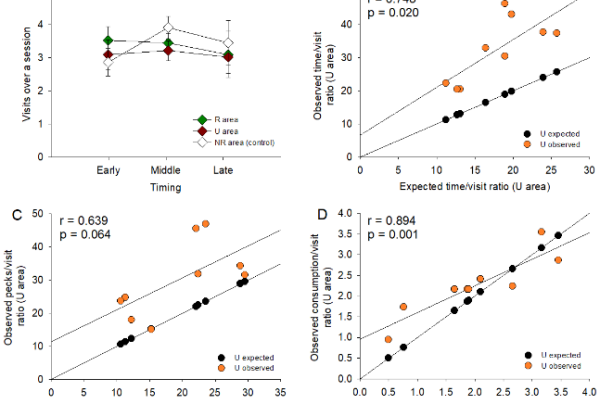2022-09-01

One major survival-related activity of organisms is to seek food in their environment. To this end, they exploit previously rewarding locations and attempt to approach the cues predictive of the edible items they detect or expect. But foraging is unlikely to be a matter of reinforcement only.
One major survival-related activity of organisms is to seek food in their environment. To this end, they exploit previously rewarding locations and attempt to approach the cues predictive of the edible items they detect or expect. But foraging is unlikely to be a matter of reinforcement only. If it was, however, foraging activity should follow principles of extinction learning: It should be abolished in a location without reinforcement and proportionally be reduced in a partially reinforced location relative to a fully reinforced one containing the same number of food items. We tested these two hypotheses using a foraging board, which allowed pigeons to find food items hidden in perforated holes. Our results showed that the overall time spent and the overall number of pecks given in one area was related to reinforcement density in that area. To a lesser extent, the same phenomenon occurred with respect to the number of visits per area. However, the time-per-visit and pecks-per-visit ratios were higher in the partially vs. fully reinforced area, suggesting that the pigeons foraged more than expected when food was uncertain. These results will be discussed in the context of the matching law and optimal foraging.
Anselme, P., Wittek, N., Oeksuez, F., Güntürkün, O. (2022). Overmatching under food uncertainty in foraging pigeons. Behavioural Processes, 201, 104728. https://doi.org/10.1016/j.beproc.2022.104728

One major survival-related activity of organisms is to seek food in their environment. To this end, they exploit previously rewarding locations and attempt to approach the cues predictive of the edible items they detect or expect. But foraging is unlikely to be a matter of reinforcement only.
One major survival-related activity of organisms is to seek food in their environment. To this end, they exploit previously rewarding locations and attempt to approach the cues predictive of the edible items they detect or expect. But foraging is unlikely to be a matter of reinforcement only. If it was, however, foraging activity should follow principles of extinction learning: It should be abolished in a location without reinforcement and proportionally be reduced in a partially reinforced location relative to a fully reinforced one containing the same number of food items. We tested these two hypotheses using a foraging board, which allowed pigeons to find food items hidden in perforated holes. Our results showed that the overall time spent and the overall number of pecks given in one area was related to reinforcement density in that area. To a lesser extent, the same phenomenon occurred with respect to the number of visits per area. However, the time-per-visit and pecks-per-visit ratios were higher in the partially vs. fully reinforced area, suggesting that the pigeons foraged more than expected when food was uncertain. These results will be discussed in the context of the matching law and optimal foraging.
Anselme, P., Wittek, N., Oeksuez, F., Güntürkün, O. (2022). Overmatching under food uncertainty in foraging pigeons. Behavioural Processes, 201, 104728. https://doi.org/10.1016/j.beproc.2022.104728